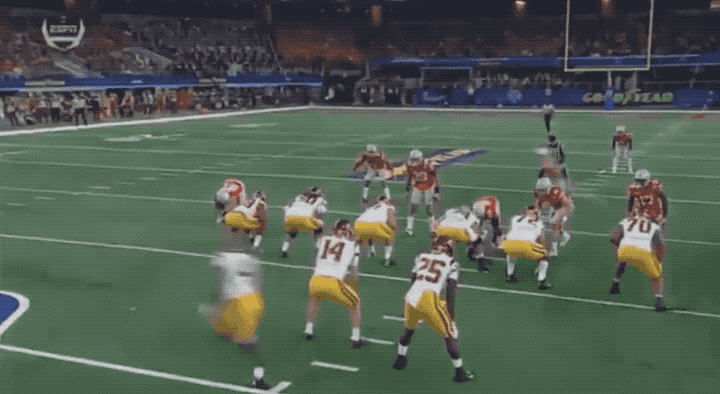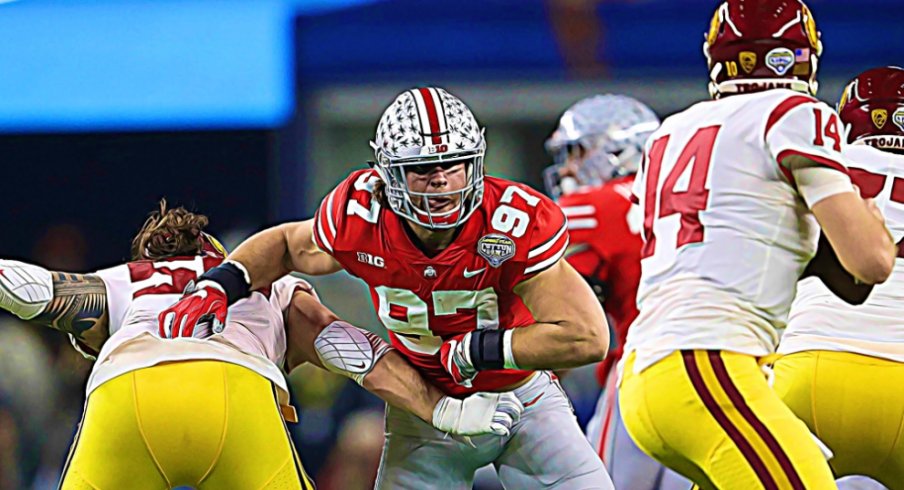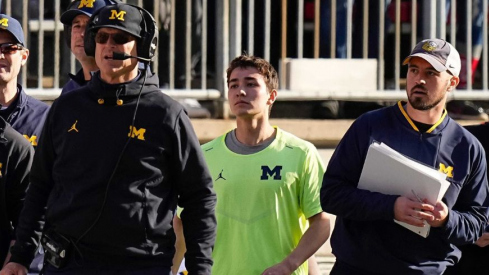Andre Wadsworth doesn’t get enough credit for Ohio State’s 2002 BCS title.
John Cooper watched in awe as Wadsworth, Greg Spires, Julian Pittman and the rest of Florida State's defensive front devoured his offense for the majority of the 1998 Sugar Bowl. Stanley Jackson and Joe Germaine combined for six interceptions that night. They also took six sacks, most of them excessively violent.
The Southern Speed (this is was the original term in the 1990s prior to the SEC holding it hostage) was on full display and undeniable. Wadsworth - somehow originally a walk-on - also had one of those interceptions. He ended up being the third player taken in the 1998 NFL Draft behind Peyton Manning and Ryan Leaf and before Charles Woodson.
“Quick, relentless pressure throughout the ballgame,” gushed Cooper. “Their pass rush was the best I’ve seen in a long time. We did not have time to throw the football.” Twenty-four hours earlier Coop had announced at the OSU pep rally in the French Quarter that his Buckeyes were going to kick the Seminoles' asses but he was unaware of the nightmare mismatch awaiting his team that would dictate the game.
It was his 20th season as a college head coach, but that evening changed him. He needed nuclear, catastrophic and wholly disruptive guys like Wadsworth on his roster. The class Coop signed the following season was more than a third (!) defensive linemen, with Kenny Peterson, Mike Collins, Ryan Pickett, Julius Yeast, David Thompson and (future LB) James Cotton in the 16-man class.
Ohio State's DEFENSIVE LINE started to look different the moment Meyer began recruiting, but the philosophy didn't catch up UNTIL Larry Johnson replaced Mike Vrabel.
Darion Scott, Will Smith, Tim Anderson and Simon Fraser were among his final recruits to Columbus. The defense Jim Tressel inherited en route to the 2002 BCS championship was almost entirely of Coop’s making. Among the primary contributors, only cornerback Dustin Fox and linebacker A.J. Hawk committed to the new regime.
The entire defensive front (which rattled Miami so badly the Hurricanes changed up their blocking schemes on their third possession for 1) the rest of the game, and 2) the first time in two seasons) was assembled in Columbus at least in part because of what happened the night the 1997 Buckeyes were introduced to Mr. Wadsworth.
Coop's guys matriculated off campus, and over time Tressel's defensive fronts were starting guys like David Patterson, Joel Penton, Dexter Larimore, Lawrence Wilson, Doug Worthington, Nader Abdallah and Garrett Goebel. Likable guys. Serviceable in the trenches. Rarely double-teamed out of being too disruptive.
None capable of altering a game or a game plan. None recruited or intended to be, either.
Alex Barrow started in the 2007 BCS title game, then quit football. When he opened up a roster spot, Tressel filled it with Keith Wells, who ended up at Ohio Dominican. Jay Richardson and Thad Gibson became linebackers at the next level in order to have a cup of coffee. John Simon has stuck around in the league much longer, largely doing the same
The studs of the era were Mike Kudla and Quinn Pitcock, both workmanlike and disruptive enough. Nathan Williams was right on the edge of that group. Tressel's freaks that merited drastic, game-planning alterations were Vern Gholston (the closest thing Ohio State had to Wadsworth) Cam Heyward (a shape-shifting demon) and Johnathan Hankins (thanks again, RichRod).
Tressel-recruited defensive linemen occupied six All-B1G 1st team spots over his decade in Columbus, which extended through Luke Fickell's interim season and Urban Meyer's arrival (Simon, Hankins). If it seems like a light number in the present context, you're right.
Over just the past four seasons alone, five of the B1G's 20 1st team spots have gone to Buckeyes, and the emphasis Ohio State puts on finding aliens to line up on the defensive side of scrimmage is on par with what we saw back when Coop had his Superdome epiphany.

Recruiting strategy isn't the only reason. Philosophy can lead or follow it - Tressel/Heacock defenses operated by having the front four occupy scrimmage in order to allow for linebackers to [Herbstreit voice] make plays in space. Linemen neutralized blockers and occasionally got a second blocker to bite - not out of disaster containment, but because that's what they were supposed to do. They allowed Linebacker U and DBU to get the highlight. Ohio State won a lot more than it lost doing this.
But there's more than one way to win with defense. Urban won a BCS title at Florida in 2006 (I looked it up, it's true) with Ray McDonald, Jarvis Moss and Derrick Harvey as nightmares up front. Ohio State's personnel at scrimmage started to look different the moment Meyer began recruiting in Columbus, but the philosophy didn't catch up until 2014 when Larry Johnson replaced Mike Vrabel as the position guru.
Now the Buckeyes send defensive linemen to the NFL to a) stick around for awhile and b) be professional defensive linemen. They'll start Nick Bosa, Robert Landers, Dre'Mont Jones and Chase Young this fall. From left to right that's 1) top five draft pick 2) probably the quickest-twitch nose tackle in school history 3) 1st round draft pick 4) literally, the Predator.
And this is what a rebuilt unit looks like, since three of the first 102 picks in the NFL Draft that just took place were Ohio State defensive linemen. Those guys aren't taking the field in 2018 to occupy space, chew up blockers and wait for linebackers to clean up the play. They are the highlight-makers now. That's the recipe. It's also the sales pitch on the recruiting trail.
Coop realized freak pass rushers were true difference-makers that could take over games. Tressel and Heacock followed a bend-don't-break philosophy that relied on game control, clock management and field position. Meyer's teams are about creating as many mismatches as possible, on both sides of the ball (he'll always be in love with the QB keeper because of the uneven math that accompanies it).
Those mismatches are most evident in the trenches when the Buckeyes are on defense. It has a chilling effect when it's neutralized, as Oklahoma did with a mobile Heisman QB smart and accurate enough to pick on OSU's linebackers, and in Iowa City the moment Nick Bosa was ejected for targeting.
That night in Tempe would have been impossible without the defensive linemen Cooper brought to Columbus. As good as Cardale, Zeke and the Buckeye offense were during that 2014 postseason run, it was the defensive line that controlled those final three games. Bend-don't-break was often good enough to win the conference during the Tressel Decade. The current philosophy is built to capture What Comes After That.
However long we keep Meyer - and Johnson - on the sideline in Columbus, the only thing that's supposed to bend and break will be whatever lines up opposite the Buckeyes' front four. For those of us old enough to remember that Florida State Sugar Bowl, this is definitely the right side of the nightmare.



